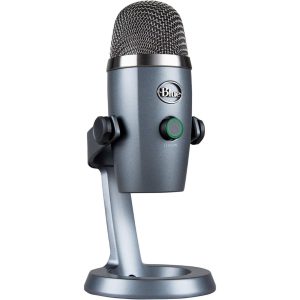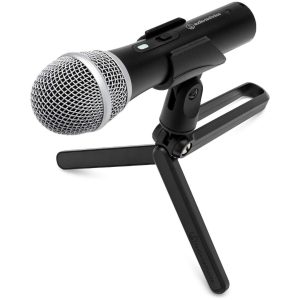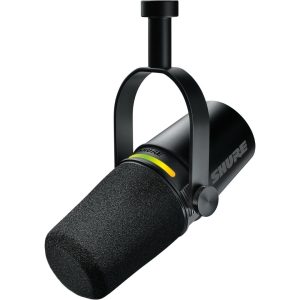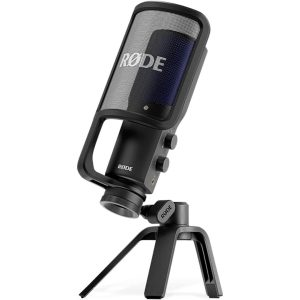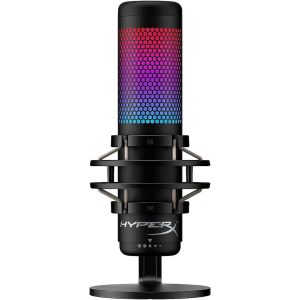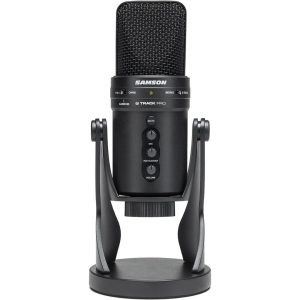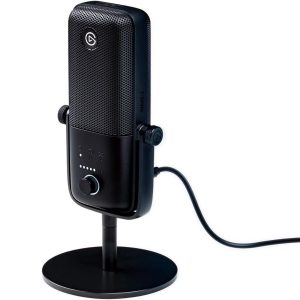Table of Contents
In today’s era of remote work and virtual meetings, the quality of your microphone can significantly influence your Zoom experience. Whether you’re delivering a pitch to clients, engaging in virtual happy hour with friends, or leading a team discussion, clear and reliable audio is absolutely crucial. However, navigating through the multitude of microphone options available can be overwhelming. But fret not! We’ve conducted thorough research to simplify the process and guide you toward selecting the perfect microphone that aligns with both your needs and budget.
Our mission is to simplify this selection process for you. We’ve evaluated numerous microphones based on criteria such as sound quality, ease of use, versatility, and value for money. Whether you’re a seasoned professional looking for studio-grade audio or a casual user seeking an upgrade from your laptop’s built-in microphone, we’ve identified top contenders that excel in various aspects.
Stay tuned as we delve into detailed reviews, practical recommendations, and expert tips to ensure you find the ideal microphone for your Zoom calls. With our guidance, you’ll soon be equipped with the perfect tool to amplify your voice and make a lasting impression in every virtual meeting.
Choosing the right microphone is not just about enhancing your audio quality—it’s about optimizing your virtual presence and ensuring seamless communication in today’s digital landscape. Let’s embark on this journey together to find the microphone that brings clarity, professionalism, and reliability to your Zoom meetings.
Top 7 Microphones for Zoom
1. Blue Yeti Nano
The Blue Yeti Nano is renowned for its exceptional sound quality, making it a favorite among professionals and enthusiasts alike. With its compact design and multiple pickup patterns, it offers versatility for various recording scenarios, making it an ideal choice for upgrading your Zoom calls.
- Renowned for its exceptional sound quality, the Blue Yeti Nano captures crystal-clear audio, perfect for professional Zoom calls.
- Easy plug-and-play setup, making it ideal for beginners.
- Compact design with multiple pickup patterns for versatile use.
- Sensitive to background noise, so a quiet environment is recommended.
- Larger than some other portable options, which may not suit all setups.
2. Audio-Technica ATR2100x-USB
The Audio-Technica ATR2100x-USB strikes a balance between affordability and performance, catering to both beginners and seasoned users. Its dual USB/XLR connectivity and built-in headphone jack provide flexibility, ensuring clear and reliable audio during your Zoom meetings.
- Excellent balance of affordability and quality, ideal for budget-conscious Zoomers.
- Dual USB/XLR connectivity offers flexibility for different setups.
- Built-in headphone jack for real-time monitoring.
- May require additional accessories like a pop filter for optimal performance.
- Some users report minor issues with durability over time.
3. Shure MV7
The Shure MV7 combines studio-quality sound with modern features like touch panel controls, offering users a seamless experience in virtual meetings. Whether you’re podcasting or leading a conference call, its dynamic or condenser mode adapts to your needs with ease.
- Studio-quality sound with a dynamic or condenser mode, adaptable for various recording needs.
- Built-in touch panel for quick adjustments without disrupting your Zoom call.
- Compatible with both USB and XLR connections.
- Pricier than entry-level microphones, targeting more serious Zoom users.
- Requires some tweaking to find the best sound settings initially.
4. Rode NT-USB Mini
Compact yet powerful, the Rode NT-USB Mini delivers exceptional audio clarity with a cardioid pickup pattern, perfect for reducing background noise in Zoom calls. Its integrated pop filter and sleek design make it a stylish addition to any workspace.
- Sleek, compact design perfect for smaller workspaces.
- Exceptional sound quality with a cardioid pickup pattern, minimizing background noise.
- Integrated pop filter for clear speech reproduction.
- Limited to USB connection only, limiting compatibility with some professional audio setups.
- Some users may find the volume levels slightly lower compared to other models.
5. HyperX QuadCast S
With vibrant RGB lighting and an anti-vibration shock mount, the HyperX QuadCast S not only enhances your audio quality but also adds a touch of personality to your virtual meetings. Its four selectable polar patterns offer flexibility for various recording environments.
- RGB lighting for that extra gamer flair during your Zoom calls.
- Anti-vibration shock mounts to reduce noise and ensure stable positioning.
- Four selectable polar patterns for flexibility in different recording environments.
- The RGB lighting might be a bit too flashy for more traditional work environments.
- Higher price point compared to basic USB microphones.
6. Samson G-Track Pro
The Samson G-Track Pro is an all-in-one solution designed for streamers and podcasters, offering dual 1″ condenser capsules and an integrated audio interface. Whether you’re hosting webinars or collaborating in team meetings, its versatility and professional-grade features shine through.
- All-in-one solution with a built-in audio interface, ideal for streamers and podcasters.
- Dual 1″ condenser capsules for rich, detailed audio capture.
- Multiple pickup patterns and instrument input for versatile recording options.
- Larger footprint compared to simpler microphones, requiring more desk space.
- The higher learning curve for beginners is due to its advanced features.
7. Elgato Wave 3
Equipped with Clipguard technology and a capacitive mute sensor, the Elgato Wave:3 ensures distortion-free audio and seamless control during your Zoom calls. Its Stream Deck integration allows for customizable audio adjustments, catering to advanced users seeking professional performance.
- Proprietary Clipguard technology prevents audio distortion, perfect for enthusiastic speakers.
- Capacitive mute sensor with LED indicator for seamless control during Zoom meetings.
- Stream Deck integration for customizable audio controls.
- Software may require updates for optimal performance, potentially causing minor inconvenience.
- Higher price point due to its professional-grade features.
How We Made the List
Choosing the best microphones for Zoom involved a meticulous process of testing, evaluation, and comparison across several key criteria. Here’s an in-depth look at how we curated our list to help you find the perfect microphone for your Zoom calls:
1. Sound Quality
Sound quality is paramount when selecting a microphone for virtual meetings. We prioritized models that deliver clear, natural-sounding audio, ensuring that every word is captured with precision and clarity. Microphones with advanced condensers or dynamic capsules were favored for their ability to reproduce voices faithfully and minimize background noise, creating a professional-grade audio experience.
During our testing phase, we assessed each microphone’s performance across different environments—from quiet home offices to bustling co-working spaces. We paid particular attention to how well each model handled various frequencies and volumes, ensuring consistent sound quality without distortion or muddiness. This rigorous approach allowed us to identify microphones that excel in providing crisp, intelligible audio, essential for effective communication in Zoom meetings.
2. Ease of Use
A user-friendly setup is crucial, especially for those new to external microphones or remote conferencing. We evaluated each microphone’s installation process, looking for plug-and-play functionality that minimizes technical hurdles. Intuitive controls for adjusting volume levels, mute settings, and monitoring headphone outputs were also considered, enhancing usability during Zoom calls.
Additionally, we assessed how well each microphone integrated with Zoom’s software interface, ensuring seamless compatibility and straightforward configuration. Models that offered simple yet effective features, such as onboard mute buttons or LED indicators for status updates, were prioritized for their ability to streamline the user experience without sacrificing functionality.
3. Compatibility
Compatibility with Zoom and other conferencing platforms was a critical factor in our selection process. We tested each microphone across a range of popular video conferencing software to assess compatibility and performance consistency. Models that maintained reliable connectivity and audio clarity across different platforms—including Zoom, Microsoft Teams, and Google Meet—were highlighted for their versatility and adaptability in diverse virtual meeting environments.
Moreover, we considered microphones that support both USB and XLR connections, offering flexibility for users with varying audio setups. This dual compatibility ensures that the microphone can adapt to different devices and configurations, whether you’re using a laptop, desktop computer, or professional audio interface.
4. Value for Money
Finding the right balance between performance and affordability was central to our recommendations. We analyzed each microphone’s features, build quality, and overall performance relative to its price point, aiming to provide options that cater to different budget constraints without compromising on essential functionalities.
High-value features such as multiple pickup patterns, built-in audio interfaces, and premium build materials were weighed against their cost to determine their cost-effectiveness. Our goal was to recommend microphones that offer excellent performance per dollar spent, ensuring that users receive maximum value and satisfaction from their investment in a quality Zoom microphone.
In conclusion, our methodology for selecting the best microphones for Zoom calls was grounded in rigorous testing and evaluation across key criteria: sound quality, ease of use, compatibility, and value for money. By prioritizing clear audio reproduction, intuitive setup, seamless compatibility with Zoom and other platforms, and cost-effective performance, we identified a range of top-performing microphones suited to enhance your virtual communication experience.
How to Choose the Best Microphone for Zoom
Selecting the right microphone for your Zoom calls involves considering several critical factors that impact audio quality, usability, and compatibility. Here’s a comprehensive guide to help you navigate through the decision-making process and find the microphone that best suits your needs:
1. Usage Environment
Before choosing a microphone, assess your workspace to understand its acoustic characteristics and potential sources of background noise. A quiet home office may only require a microphone with basic noise-canceling features, while a shared workspace or high-traffic area might benefit from a microphone with advanced noise-reduction capabilities.
Consider whether you need additional acoustic treatment, such as soundproofing or acoustic panels, to minimize reverberations and external disturbances. Understanding your environment will guide you in selecting a microphone that can deliver clear, uninterrupted audio during Zoom calls, enhancing overall communication effectiveness.
2. Connection Type
Microphones typically come in two primary connection types: USB and XLR.
- USB Microphones: These are plug-and-play devices that connect directly to your computer or laptop via a USB port. They offer simplicity and convenience, making them ideal for users who prioritize ease of setup and use. USB microphones are suitable for most personal and professional Zoom setups, providing reliable audio quality without the need for additional equipment.
- XLR Microphones: Designed for more advanced audio setups, XLR microphones require an audio interface or mixer for connectivity to your computer. They offer greater flexibility and customization options, making them preferred choices for professionals and enthusiasts seeking studio-grade audio performance. XLR microphones are ideal for users who require precise control over their audio settings and plan to expand their setup with additional equipment.
When deciding between USB and XLR microphones, consider your current setup, future audio needs, and the level of control and customization you require for your Zoom calls.
3. Pickup Pattern
The pickup pattern of a microphone determines how it captures sound from different directions. Choosing the right pickup pattern is crucial for optimizing audio quality based on your specific usage scenarios:
- Cardioid: Ideal for solo Zoom calls, interviews, or presentations where you want to capture sound primarily from the front of the microphone while minimizing background noise from the sides and rear. Cardioid microphones are excellent for creating a focused audio pickup, enhancing clarity, and reducing distractions during individual or small group meetings.
- Omnidirectional: Suitable for group discussions or conference calls where you need to capture sound equally from all directions. Omnidirectional microphones are effective in picking up voices from multiple participants in a room, making them ideal for collaborative meetings or virtual events involving larger groups.
- Bidirectional (Figure-8): Captures sound from the front and rear of the microphone while rejecting sound from the sides. Bidirectional microphones are useful for one-on-one interviews or discussions where two participants are facing each other, allowing for clear audio capture from both individuals without picking up ambient noise from the surroundings.
Select a microphone with a pickup pattern that aligns with your typical Zoom call scenarios to ensure optimal audio clarity and focus on your voice or group conversation.
4. Budget
Determine your budget range for investing in a microphone, considering both the initial purchase cost and any potential additional accessories or equipment needed.
- Entry-Level Options: Budget-friendly USB microphones offer good audio quality and essential features for everyday Zoom use, making them accessible for most users without breaking the bank.
- Mid-Range Choices: Mid-priced microphones strike a balance between performance and affordability, providing enhanced sound quality and additional features such as multiple pickup patterns or advanced noise reduction capabilities.
- High-End Solutions: Professional-grade microphones and XLR setups offer superior audio fidelity, robust build quality, and extensive customization options for demanding Zoom environments or professional broadcasting needs.
Balance your budget considerations with the desired audio quality and features to find a microphone that offers the best value for your investment in enhancing your Zoom communication.
5. Reviews and Recommendations
Before making a final decision, consult user reviews and expert recommendations to gain insights into real-world performance and user satisfaction.
- User Reviews: Read feedback from other Zoom users who have tested the microphone in similar settings to gauge reliability, ease of use, and overall satisfaction.
- Expert Opinions: Seek advice from audio professionals, tech reviewers, or trusted sources who can provide unbiased assessments and comparisons of different microphone models based on performance benchmarks and industry standards.
Combining user reviews with expert insights allows you to make an informed decision, ensuring that the microphone you choose meets your expectations and performs reliably in your Zoom meetings.
6. Trial and Error
Finally, don’t hesitate to try out different microphones to find the one that best suits your voice, setup, and personal preferences. Many retailers offer flexible return policies or demo units that allow you to test microphones in your own environment before committing to a purchase.
- Testing Process: Experiment with microphone placement, adjust audio settings, and conduct test calls to evaluate audio clarity, background noise handling, and overall comfort during extended use.
- Comparative Testing: Compare the performance of multiple microphones side-by-side to identify subtle differences in sound quality, usability, and compatibility with your Zoom setup.
By engaging in a trial-and-error process, you can confidently select the best microphone that enhances your Zoom communication experience, ensuring clear, professional-grade audio for every virtual meeting.
FAQs
1. Do I need a microphone for Zoom if my laptop has a built-in microphone?
While built-in microphones are convenient, external microphones like those listed offer superior sound quality and noise cancellation capabilities. This upgrade can significantly enhance your audio clarity and overall Zoom experience, particularly in professional or collaborative settings.
2. Can I use a headset with a built-in microphone instead of a standalone microphone?
Headsets with built-in microphones are suitable for personal calls and basic communication. However, they may lack the audio fidelity and versatility required for professional Zoom meetings or presentations. Dedicated microphones, such as those listed, offer better sound quality and are designed to capture clearer, more articulate speech.
3. What’s the difference between USB and XLR microphones, and which should I choose for Zoom?
USB microphones are straightforward plug-and-play devices that connect directly to your computer via a USB port. They are convenient for most users, offering good sound quality and ease of use. In contrast, XLR microphones provide higher audio fidelity and greater flexibility but require an audio interface or mixer for connection. They are preferred by professionals or enthusiasts seeking studio-quality sound and precise control over audio settings.
4. How important is noise cancellation in a microphone for Zoom calls?
Noise cancellation is crucial for maintaining clear communication during Zoom calls, especially in environments with background noise. Microphones equipped with noise-canceling features help eliminate unwanted sounds, ensuring that your voice remains prominent and distractions are minimized, enhancing overall meeting productivity.
5. Are there any tips for improving audio quality in Zoom meetings without buying a new microphone?
Optimizing your Zoom settings, such as adjusting microphone and speaker levels, can significantly enhance audio quality. Using headphones helps prevent echo and improves sound clarity. Choosing a quiet environment for meetings reduces background noise, further enhancing the clarity and effectiveness of your audio.
6. What accessories should I consider purchasing with my new microphone for Zoom?
Consider investing in accessories such as pop filters, which reduce plosive sounds like ‘p’ and ‘t’ sounds, ensuring smoother audio recording. Mic stands offer flexibility in positioning your microphone for optimal sound capture. Acoustic panels can be beneficial in echo-prone rooms, improving overall sound quality and reducing reverberations during Zoom calls.
7. How can I prevent audio feedback during Zoom calls when using an external microphone?
Audio feedback, such as echoes or screeching sounds, can occur when sound from speakers is picked up by the microphone. To prevent this, use headphones instead of speakers to listen to audio during Zoom calls. Headphones help isolate your voice input from the audio output, reducing the likelihood of feedback and ensuring clear, uninterrupted communication.
8. How can I improve microphone placement for better audio quality in Zoom calls?
Effective microphone placement is crucial for optimizing audio quality during Zoom calls. Position the microphone at a comfortable distance from your mouth, typically 6-12 inches away, to ensure clear and natural sound capture. Avoid placing the microphone too close, which can cause distortion or unwanted breathing sounds. Experiment with different placements and angles to find the optimal position that minimizes background noise and maximizes your voice clarity, enhancing overall communication effectiveness in virtual meetings.
9. Can I use a microphone with Zoom on mobile devices like smartphones or tablets?
Yes, you can use external microphones with Zoom on mobile devices, provided they support USB or Lightning connectivity. This allows you to achieve better audio quality compared to built-in microphones, enhancing your mobile Zoom experience for professional meetings or virtual collaborations on the go.
Conclusion
Selecting the best microphone for your Zoom calls hinges on understanding your unique requirements, workspace dynamics, and budget considerations. Whether you decide on the Blue Yeti Nano or another recommended model from our curated list, investing in a quality microphone can markedly elevate your virtual communication experience.
Discover the perfect microphone for your Zoom calls today and elevate your virtual communication capabilities to new heights. Whether collaborating with colleagues, presenting to clients, or connecting with friends and family, make your voice heard with confidence and clarity, powered by a microphone that meets your unique needs and exceeds your expectations.

Hi, I’m Zoë, the founder of Remote Work Wise. For the past decade, I’ve been immersed in the world of remote work, collaborating with businesses worldwide and leading large remote teams. Alongside my ventures in remote work, I also established Wild Lotus, a digital content agency.

